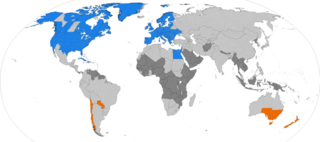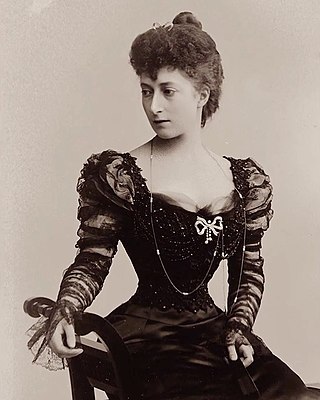Related Research Articles

Buckingham Palace is a royal residence in London, and the administrative headquarters of the monarch of the United Kingdom. Located in the City of Westminster, the palace is often at the centre of state occasions and royal hospitality. It has been a focal point for the British people at times of national rejoicing and mourning.

Balmoral Castle is a large estate house in Aberdeenshire, Scotland, and a residence of the British royal family. It is near the village of Crathie, 9 miles (14 km) west of Ballater and 50 miles (80 km) west of Aberdeen.

Edward VII was King of the United Kingdom and the British Dominions, and Emperor of India, from 22 January 1901 until his death in 1910.

George VI was King of the United Kingdom and the Dominions of the British Commonwealth from 11 December 1936 until his death on 6 February 1952. He was also the last Emperor of India from 1936 until the British Raj was dissolved in August 1947, and the first head of the Commonwealth following the London Declaration of 1949.

George V was King of the United Kingdom and the British Dominions, and Emperor of India, from 6 May 1910 until his death in 1936.

Daylight saving time (DST), also referred to as daylight saving(s), daylight savings time, daylight time (United States and Canada), or summer time (United Kingdom, European Union, and others), is the practice of advancing clocks to make better use of the longer daylight available during summer, so that darkness falls at a later clock time. The typical implementation of DST is to set clocks forward by one hour in spring or late winter, and to set clocks back by one hour to standard time in the autumn (or fall in North American English, hence the mnemonic: "spring forward and fall back").

Mary of Teck was Queen of the United Kingdom and the British Dominions, and Empress of India, from 6 May 1910 until 20 January 1936 as the wife of King-Emperor George V.

Alexandra of Denmark was Queen of the United Kingdom and the British Dominions, and Empress of India, from 22 January 1901 to 6 May 1910 as the wife of King-Emperor Edward VII.

In early December 1936, a constitutional crisis in the British Empire arose when King Edward VIII proposed to marry Wallis Simpson, an American socialite who was divorced from her first husband and was in the process of divorcing her second.

Prince John was the fifth son and youngest of the six children of King George V and Queen Mary. At the time of his birth, his father was heir apparent to John's grandfather Edward VII. In 1910, John's father succeeded to the throne upon Edward VII's death, and John became fifth in the line of succession to the British throne.

Maud of Wales was Queen of Norway as the wife of King Haakon VII. The youngest daughter of King Edward VII and Queen Alexandra of the United Kingdom, she was known as Princess Maud of Wales before her marriage, as her father was the Prince of Wales at the time.

The Pacific Time Zone (PT) is a time zone encompassing parts of western Canada, the western United States, and western Mexico. Places in this zone observe standard time by subtracting eight hours from Coordinated Universal Time (UTC−08:00). During daylight saving time, a time offset of UTC−07:00 is used.

Sandringham House is a country house in the parish of Sandringham, Norfolk, England. It is one of the royal residences of Charles III, whose grandfather, George VI, and great-grandfather, George V, both died there. The house stands in a 20,000-acre (8,100 ha) estate in the Norfolk Coast Area of Outstanding Natural Beauty. The house is listed as Grade II* and the landscaped gardens, park and woodlands are on the National Register of Historic Parks and Gardens.

Canada is divided into six time zones. Most areas of the country's provinces and territories operate on standard time from the first Sunday in November to the second Sunday in March and daylight saving time the rest of the year.

The United Kingdom uses Greenwich Mean Time and British Summer Time (UTC+01:00).
UTC+00:30 is an identifier for a time offset from UTC of +00:30.

Wolferton was a railway station on the Lynn and Hunstanton Railway line which opened in 1862 to serve the village of Wolferton in Norfolk, England. The station was also well known as the nearest station to Sandringham House, and royal trains brought the royal family to and from their estate until the station's closure in 1969.

Edward VIII, later known as the Duke of Windsor, was King of the United Kingdom and the Dominions of the British Empire, and Emperor of India, from 20 January 1936 until his abdication in December of the same year.

The coronation of George VI and his wife, Elizabeth, as king and queen of the United Kingdom and the Dominions of the British Commonwealth, Emperor and Empress consort of India took place at Westminster Abbey, London, on Wednesday 12 May 1937. George VI ascended the throne upon the abdication of his brother, Edward VIII, on 11 December 1936, three days before his 41st birthday. Edward's coronation had been planned for 12 May and it was decided to continue with his brother and sister-in-law's coronation on the same date.

On 6 February 1952, George VI, King of the United Kingdom, died at the age of 56, at Sandringham House, after battling with a prolonged cancer. His state funeral took place on 15 February 1952. A period of national mourning commenced and his eldest daughter and successor, Queen Elizabeth II was proclaimed the new monarch by the Accession Council. George VI's coffin lay in St Mary Magdalene Church, Sandringham until 11 February when it was carried, in procession, to the nearby Wolferton railway station. The coffin was carried by train to London King's Cross railway station where another formal procession carried it to Westminster Hall where the king lay in state for three days. Some 304,000 people passed through Westminster Hall with queues up to 4 miles (6.4 km) forming.
References
- ↑ Vickers, Hugo (2006). Elizabeth: The Queen Mother. Arrow Books/Random House. p. 129.
- ↑ "Summer Time Pioneer" . Hartlepool Northern Daily Mail. 24 December 1932. Retrieved 9 September 2016– via British Newspaper Archive.
- ↑ David Prerau (2005). Seize the Daylight: The Curious and Contentious Story of Daylight Saving Time . Thunder’s Mouth Press. ISBN 1-56025-655-9. The British version, focusing on the UK, is Saving the Daylight: Why We Put the Clocks Forward. Granta Books. 2005. ISBN 1-86207-796-7.
- ↑ "Great Activity at Sandringham" . Aberdeen Journal. 24 December 1936. Retrieved 9 September 2016– via British Newspaper Archive.